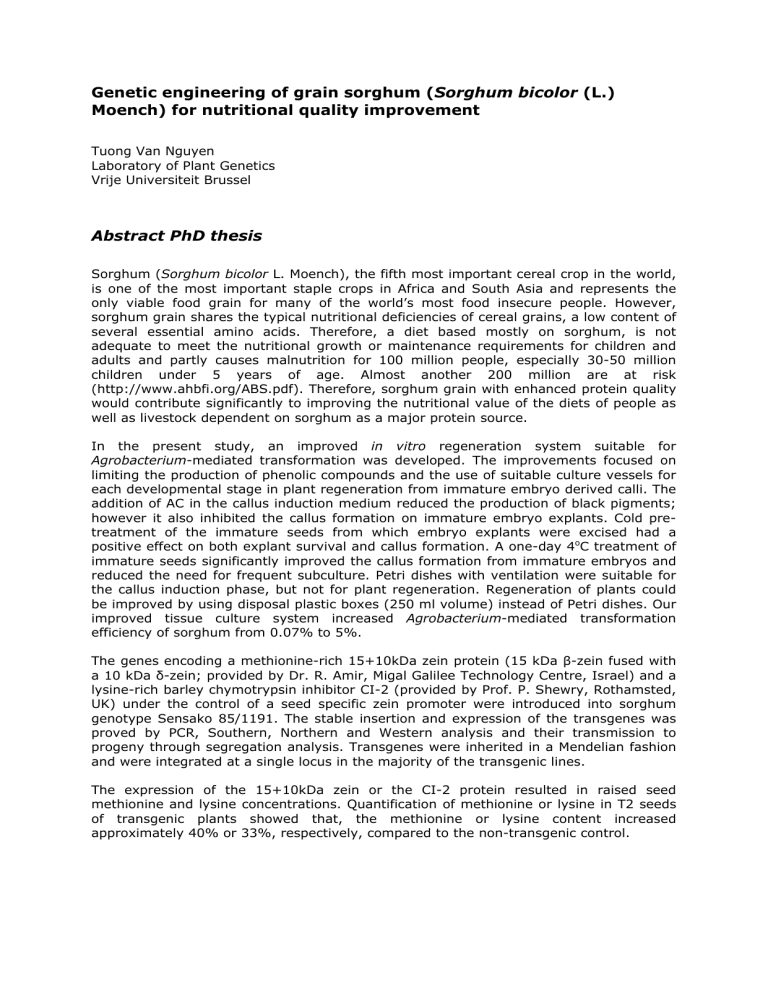
Genetic engineering of grain sorghum (Sorghum bicolor (L.)
Moench) for nutritional quality improvement
Tuong Van Nguyen
Laboratory of Plant Genetics
Vrije Universiteit Brussel
Abstract PhD thesis
Sorghum (Sorghum bicolor L. Moench), the fifth most important cereal crop in the world,
is one of the most important staple crops in Africa and South Asia and represents the
only viable food grain for many of the world’s most food insecure people. However,
sorghum grain shares the typical nutritional deficiencies of cereal grains, a low content of
several essential amino acids. Therefore, a diet based mostly on sorghum, is not
adequate to meet the nutritional growth or maintenance requirements for children and
adults and partly causes malnutrition for 100 million people, especially 30-50 million
children under 5 years of age. Almost another 200 million are at risk
(http://www.ahbfi.org/ABS.pdf). Therefore, sorghum grain with enhanced protein quality
would contribute significantly to improving the nutritional value of the diets of people as
well as livestock dependent on sorghum as a major protein source.
In the present study, an improved in vitro regeneration system suitable for
Agrobacterium-mediated transformation was developed. The improvements focused on
limiting the production of phenolic compounds and the use of suitable culture vessels for
each developmental stage in plant regeneration from immature embryo derived calli. The
addition of AC in the callus induction medium reduced the production of black pigments;
however it also inhibited the callus formation on immature embryo explants. Cold pretreatment of the immature seeds from which embryo explants were excised had a
positive effect on both explant survival and callus formation. A one-day 4oC treatment of
immature seeds significantly improved the callus formation from immature embryos and
reduced the need for frequent subculture. Petri dishes with ventilation were suitable for
the callus induction phase, but not for plant regeneration. Regeneration of plants could
be improved by using disposal plastic boxes (250 ml volume) instead of Petri dishes. Our
improved tissue culture system increased Agrobacterium-mediated transformation
efficiency of sorghum from 0.07% to 5%.
The genes encoding a methionine-rich 15+10kDa zein protein (15 kDa β-zein fused with
a 10 kDa δ-zein; provided by Dr. R. Amir, Migal Galilee Technology Centre, Israel) and a
lysine-rich barley chymotrypsin inhibitor CI-2 (provided by Prof. P. Shewry, Rothamsted,
UK) under the control of a seed specific zein promoter were introduced into sorghum
genotype Sensako 85/1191. The stable insertion and expression of the transgenes was
proved by PCR, Southern, Northern and Western analysis and their transmission to
progeny through segregation analysis. Transgenes were inherited in a Mendelian fashion
and were integrated at a single locus in the majority of the transgenic lines.
The expression of the 15+10kDa zein or the CI-2 protein resulted in raised seed
methionine and lysine concentrations. Quantification of methionine or lysine in T2 seeds
of transgenic plants showed that, the methionine or lysine content increased
approximately 40% or 33%, respectively, compared to the non-transgenic control.

